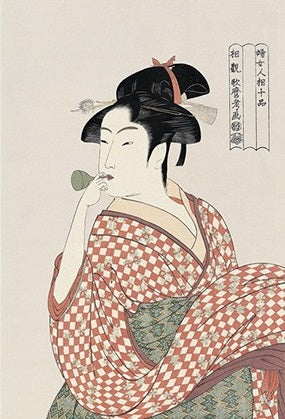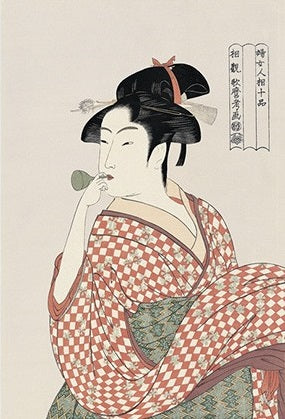アダチ版画研究所
Ukiyo-e Kitagawa Utamaro "Girl blowing a glass toy"
Ukiyo-e Kitagawa Utamaro "Girl blowing a glass toy"
Couldn't load pickup availability
Utamaro used the idea of a beauty playing with a glass toy in two of his great masterpiece series. The first series was the "Fujo Ninso Juppin (Ten Physiognomic Aspects of Women)"; the second series was the "Fujin Sogaku Juttai (Ten Physiognomic Types of Women)".
Both series were published in the early part of the Kansei era (early 1790’s). The second series was published a little later than the first, and it is from the second series that the print at hand derives. In these two series Utamaro attempted to classify his feminine subjects according to "aspect" or "type", and the signatures he used on some of the prints would indicate that he regarded himself as a "physiognomist", that is, as a professional reader of character by observing and recording the lineaments of the face or form of the body.
The print at hand is signed Sokan Utamaro koga, which means "designed by Utamaro, the physiognomist." Other prints in the same series are signed Somi Utamaro ga, which means "drawn by Utamaro, the physiognomist." In some of the prints (in both series) Utamaro evidently intended also to portray certain social classes, for example, the refined woman, the ordinary woman, and the vulgar woman.
However, several of the portraits do not seem to cover any particular social classification, and the portrait here of a healthy young woman with Taka-shimada coiffure, playing with a glass toy, seem to belong to this latter category.
The difference between the two series―"Aspects" and "Types"―can determined by studying the exact meaning of the key words used in the titles. The first involves the word hin, which means aspects, or classification of things. The second involves the word tai, which literally means bodies. The latter word is more comprehensive and more concrete, and the Jittai series was, in fact, a little more advanced and more penetrating than the earlier Juppin series.
The print here of the girl with a glass toy is usually captioned as "a beauty blowing a bidoro," but I believe that is not a correct description. Bidoro is a term correctly used only in connection with the glass blowing in glass manufacture. The beauty here is playing with a glass toy, which is sometimes called a "poppin." It is a very thin glass object with a bulb covered by a thin diaphragm, and a pipe at the other end. When the pipe is blown or sucked, the diaphragm makes a soft popping sound. It is essentially a children’s toy and rather similar to the Hozuki (seed-pod of the Herefusus ternatanus) which are occasionally depicted as accessories in ukiyo-e and which Japanese children still play with today. When I was a child, the glass poppin toys were sold in cheap candy shops in Tokyo. At that time we called them "pekopon," and I can remember being cautioned by my family elders that the toys were dangerous to the throat in case a broken fragment of glass was inhaled.
| screen dimensions | 39.0×26.5cm |
| Forehead size | 55.5×40.0cm |

FAQ
I would like to combine multiple orders, is that possible?
Excuse us but please note that all products on this site are shipped directly from the producers, so we cannot bundle multiple ordered products.
When will the item be delivered?
As a general rule, we will ship within 7 business days after payment is confirmed. However, the shipping date may differ depending on the arrival status of the product.
*If we are unable to prepare the ordered product for reasons such as being out of stock, we will contact you by email and discuss the matter with you.
I would like a refund for this item.
Please request a return from the inquiry page of this site within 8 days after the product arrives, and promptly return the product to the location specified by the customer center. In addition, the shipping fee for returning the product will be borne by the customer. For details, please see "Specified Commercial Transaction Law".

